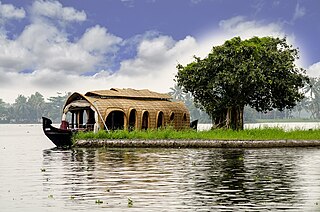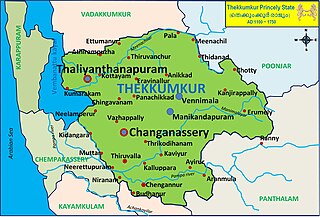
The Kingdom of Travancore, also known as the Kingdom of Thiruvithamkoor or later as Travancore State, was a kingdom that lasted from c. 1729 until 1949. It was ruled by the Travancore Royal Family from Padmanabhapuram, and later Thiruvananthapuram. At its zenith, the kingdom covered most of the south of modern-day Kerala and the southernmost part of modern-day Tamil Nadu with the Thachudaya Kaimal's enclave of Irinjalakuda Koodalmanikyam temple in the neighbouring Kingdom of Cochin. However Tangasseri area of Kollam city and Anchuthengu near Attingal in Thiruvananthapuram were parts of British India.

Anizham Thirunal Marthanda Varma was the founding monarch of the southern Indian Kingdom of Travancore from 1729 until his death in 1758. He was succeeded by Rama Varma (1758–98).

Mavelikara is a municipality in the Alappuzha district of Kerala, India. It is located 43 km (26.7 mi) south of the district headquarters in Alappuzha and about 95 km (59.0 mi) north of the state capital Thiruvananthapuram. As per the 2011 Indian census, Mavelikara has a population of 26,421 people, and a population density of 2,088/km2 (5,410/sq mi).

The Battle of Colachel was fought on 10 August 1741 [O.S. 31 July 1741] between the Indian kingdom of Travancore and the Dutch East India Company. During the Travancore-Dutch War, King Marthanda Varma's (1729–1758) forces defeated the Dutch East India Company's forces led by Admiral Eustachius De Lannoy on 10 August 1741. The Dutch never recovered from the defeat and no longer posed a large colonial threat to India. Travancore triumphed in the war thanks to the exceptional military efforts of the Travancore Nair Brigade at sea, along with the leadership of three Nair commanders—Arumukhan Pilla, Nanu Pilla, and Chembaka Raman Pilla—on land. Though in the war with Kayamkulam a regiment of Maravar from Tinnevelly under Ponnan Pandya Tevar also co-operated. It was the same army that defeated the Dutch at Colachel, where also the military genius of Ramayyan, not to speak of that of the Maharaja, was in conspicuous evidence.

Gustaaf Willem, Baron van Imhoff was a Dutch colonial administrator for the Dutch East India Company (VOC). He served as Governor of Ceylon from 1736 to 1740 and as Governor-General of the Dutch East Indies from 1743 until his death in 1750 at Istana Cipanas.
Odanad was a feudal state in late medieval Kerala. It was established in the 11th century, and disestablished in 1746 when it became part of Travancore after Venad King Marthanda Varma's northern expedition. The last king of Odanad was King Kotha Varma. At the time of its dissolution, it was composed of the present-day taluks of Mavelikkara, Karthikapally, Chenganur in the Alappuzha district and Karunagapally in the Kollam district. Another name of onattukara is kayamkulam. In the 15th century, the capital of Odanad was moved from Kandiyoor-Muttom to Eruva and Krishnapuram in Kayamkulam, which led to the state being called Kayamkulam. After this shift, Kayamkulam became the commercial centre of Odanad, while Mavelikkara remained its cultural centre. Odanad was controlled by Nair lords, among whom the ruler of Kayamkulam was the most prominent.

Alappuzha, formerly known as Alleppey, is a city and municipality in the Alappuzha district of Kerala, India. It is the district headquarters of the district, and is located about 130 km (80.8 mi) north of the state capital Thiruvananthapuram. As per the 2011 Indian census, Alappuzha has a population of 240,991 people, and a population density of 3,675/km2 (9,520/sq mi).

Kilimanoor is a panchayat and a town in the Chirayinkeezhu taluk of Thiruvananthapuram district in Kerala, India. It is located on MC/SH 1 Road, 33 kilometres (21 mi) North-west of the city of Thiruvananthapuram (Trivandrum), 14 km (8.7 mi) east of Attingal and 20 km (12 mi) east of Varkala.

Rama Varma I often referred to as Dharma Raja, was the Maharajah of Travancore from 1758 until his death in 1798. He succeeded his uncle Marthanda Varma, who is credited with the title of "maker of modern Travancore". During his reign Dharma Raja not only retained all the territories his predecessor had gained but administered the kingdom with success. He was addressed as Dharma Raja on account of his strict adherence to Dharma Sastra, the Hindu principles of justice by providing asylum to thousands of Hindus and Christians fleeing Malabar during the Mysorean conquest of Malabar.

Velayudhan Chempakaraman Thampi ofThalakulam (1765–1809) was the Dalawa or Prime Minister of the Indian kingdom of Travancore between 1802 and 1809 during the reign of Bala Rama Varma Kulasekhara Perumal. He is best known for being one of the earliest individuals to rebel against the British East India Company's authority in India.

The Travancore–Dutch War was a war between the Dutch East India Company (VOC) and the Indian kingdom of Travancore, culminating in the Battle of Colachel in 1741. Travancore won the war with the notable military service of fishermen community at the sea and seashore while Ananthapadmanabhan as commander in chief of the army at the land.

The Kingdom of Thekkumkur was an independent kingdom in the southern part of Kerala in India from 1103 CE until 1750 CE. It was ruled by the Thekkumkur Royal Family. Thekkumkur lies between the Meenachil River and the Pamba River, from the Western Ghats to the Vembanad Kayal. Thekkumkur emerged as a result of administrative changes in the princely states at the end of the Chera Kulasekhara dynasty of Mahodayapuram. The literal meaning of the title is the southern regent and the attribute southern distinguished them from another kingdom known as Vadakkumkur which bordered it in the northern side. The royal household, Thekkumkur Kovilakam, were at Vennimala and Manikandapuram near Puthuppally, later it shifted to Neerazhi Palace at Puzhavathu of Changanassery and Thalilkotta at Thaliyanthanapuram (Kottayam).

Eustachius Benedictus de Lannoy was a skilled military strategist and commander of the Travancore army, under Maharaja Marthanda Varma.
Rajah Rama Varma was the ruler of the Indian kingdom of Venad, later known as Travancore, in the modern day state of Kerala, India between 1724 and 1729, having succeeded his brother Unni Kerala Varma. He is better known as the uncle of Maharajah Padmanabha Dasa Vanchi Pala Marthanda Varma Kulasekhara Perumal, the "maker of modern Travancore". He was born into the Royal Family of Kolathunadu, as the second son of Rajah Ittamar of Thattari Kovilakam. It was princes from the Parappanadu family who customarily married Kolathunadu princesses. Rama Varma's entire family, including himself, two sisters and his elder brother Unni Kerala Varma, were adopted into the Venad house as members of the Travancore Royal Family by Rajah Ravi Varma, nephew of Umayamma Rani due to the failure of heirs there. Ittammar Raja's sister and her sons, Rama Varma and Raghava Varma, settled in Kilimanoor and married the now adopted sisters. Of the adopted sisters, one died soon after her adoption while the other was the mother of the Maharajah Marthanda Varma.

The Travancore royal family was the ruling house of the Kingdom of Travancore. The Travancore royal family signed a treaty with the British in 1788, thereby adopting British dominance. Later, in 1805, they revised the treaty, leading to a diminution of royal authority and the loss of political independence for Travancore. They had to give up their ruling rights over the common people in 1949 when Travancore were forced to merge with Independent India and their political pension privileges were abolished in 1971.
Palliyarathalam Bhadrakali Kshethram is an ancient temple located at Nedumpuram East in Pathanamthitta in the Indian state of Kerala. The deities of the temple are Devi (Bhadrakali) and Shiva. The temple belongs to Travancore Devaswom Board.

The Battle of Changanacherry was a battle between the kingdoms of Thekkumkur and Travancore in September 1749. Defeat in this decisive battle led to Thekkumkur losing its dominance and expanding the Tranvancore empire to the southern border of the river Meenachilar.

Aditya Varma Manikandan popularly known as Aditya Varman, was the last ruling Maharaja of the Princely State of Thekkumkur. He was the ruler until September 1749 when the king of Travancore Anizham Thirunal Marthanda Varma ousted him from Neerazi Palace at the Battle of Changanassery. Thekkumkur kings were known as Manikandan. The goddess was Cheruvally Bhagavathi in the space. The official residence of Sri Aditya Varma was Neerazi Palace.

The Chanda Sahib invasion of Travancore was a military expedition of the Carnatic Sultanate under Chanda Sahib against the Kingdom of Travancore in 1740, in South India. In the event, the Carnatic Sultanate invaded the Kingdom of Travancore, resulting in the Carnatic forces defeating the Travancore army led by Ramayyan Dalawa.













